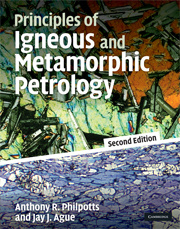Book contents
- Frontmatter
- Contents
- Preface
- Acknowledgments
- List of units
- 1 Introduction
- 2 Physical properties of magma
- 3 Intrusion of magma
- 4 Forms of igneous bodies
- 5 Cooling of igneous bodies and other diffusion processes
- 6 Classification of igneous rocks
- 7 Introduction to thermodynamics
- 8 Free energy and phase equilibria
- 9 Thermodynamics of solutions
- 10 Phase equilibria in igneous systems
- 11 Effects of volatiles on melt equilibria
- 12 Crystal growth
- 13 Isotope geochemistry related to petrology
- 14 Magmatic processes
- 15 Igneous rock associations
- 16 Metamorphism and metamorphic facies
- 17 Deformation and textures of metamorphic rocks
- 18 Graphical analysis of metamorphic mineral assemblages
- 19 Geothermometry, geobarometry, and mineral reactions among solid solutions
- 20 Mineral reactions involving H2O and CO2
- 21 Material transport during metamorphism
- 22 Pressure–temperature–time paths and heat transfer during metamorphism
- 23 Origin of rocks
- Answers to selected numerical problems
- References
- Index
3 - Intrusion of magma
- Frontmatter
- Contents
- Preface
- Acknowledgments
- List of units
- 1 Introduction
- 2 Physical properties of magma
- 3 Intrusion of magma
- 4 Forms of igneous bodies
- 5 Cooling of igneous bodies and other diffusion processes
- 6 Classification of igneous rocks
- 7 Introduction to thermodynamics
- 8 Free energy and phase equilibria
- 9 Thermodynamics of solutions
- 10 Phase equilibria in igneous systems
- 11 Effects of volatiles on melt equilibria
- 12 Crystal growth
- 13 Isotope geochemistry related to petrology
- 14 Magmatic processes
- 15 Igneous rock associations
- 16 Metamorphism and metamorphic facies
- 17 Deformation and textures of metamorphic rocks
- 18 Graphical analysis of metamorphic mineral assemblages
- 19 Geothermometry, geobarometry, and mineral reactions among solid solutions
- 20 Mineral reactions involving H2O and CO2
- 21 Material transport during metamorphism
- 22 Pressure–temperature–time paths and heat transfer during metamorphism
- 23 Origin of rocks
- Answers to selected numerical problems
- References
- Index
Summary
INTRODUCTION
Most field evidence indicates that igneous rocks have formed from upward-moving bodies of either magma, mixtures of magma and crystals, magma and gas bubbles, or even solid rock. Basaltic lava flows cover most of the ocean floor and large areas on continents. Rhyolitic lava flows and volcanic ash also cover large parts of continents. Clearly, magma of a wide range of composition is able to rise to the Earth's surface.
Exposures of deeply eroded parts of the crust reveal that basaltic magmas most commonly rise through fractures and, on cooling, form steeply dipping sheet-like intrusions known as dikes. Rhyolitic magmas, in contrast, tend to rise in large dome-like bodies known as diapirs, which, on solidifying beneath the surface, form granite batholiths. Still other magmas with high volatile contents such as kimberlite, which bring diamonds up from depths of approximately 200 km, rise through pipe-like bodies known as diatremes and erupt explosively onto the Earth's surface.
Regardless of the mode by which magma ascends, buoyancy is the main driving force. Magmas are simply less dense than most rocks and so tend to float toward the Earth's surface. When the upper mantle partially melts, a basaltic liquid is formed that is less dense than the refractory residue, so the liquid begins to rise. It does so slowly at first as an interstitial liquid moving through the pores of the deformable crystal mush (McKenzie, 1984). The flow then becomes channelized (Kelemen et al., 1995), and the pressure causing the magma to rise is sufficient to propagate fractures through the lithosphere.
- Type
- Chapter
- Information
- Principles of Igneous and Metamorphic Petrology , pp. 28 - 51Publisher: Cambridge University PressPrint publication year: 2009



